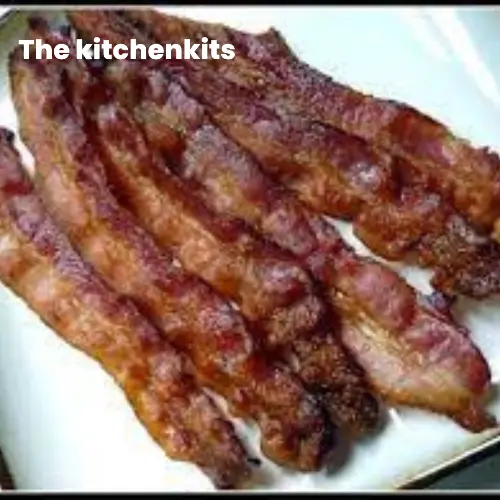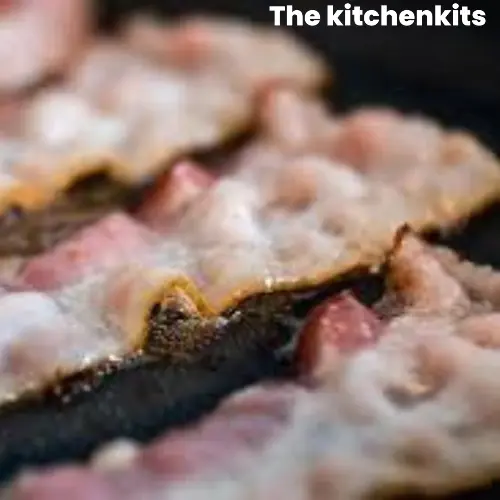Thekitchenkits.online is an Amazon Associate and earns from qualifying purchases made through affiliate links on our site at no extra cost to you. This supports our efforts to bring you valuable kitchen-related content.
Table of Contents
How to Cook Bacon in a Toaster Oven
Looking for a hassle-free way to cook bacon that yields crispy, flavorful strips every time? Say goodbye to splattering stovetops and crowded frying pans. In this guide, we’ll show you how to master the art of cooking bacon in a toaster oven, unlocking a quick and convenient method that guarantees delicious results
In this guide, we’ll unlock the secrets to achieving bacon nirvana right in the cozy confines of your toaster oven. Get ready to elevate your breakfast game and tantalize your taste buds as we dive into cooking bacon in a toaster oven.
Say goodbye to greasy stovetops and hello to a whole new level of bacon brilliance. Let’s embark on this flavorful journey together!
Necessary Tools for Cooking Bacon in a Toaster Oven
Before diving into the steps for cooking a slice of bacon, let’s grab the essential ingredients first. To cook bacon in a toaster oven, you’ll need the following tools:
- Toaster oven: Ensure that your toaster oven is clean and in proper working condition.
- Baking pan or wire rack: Use a pan or rack that fits inside your toaster oven and allows the bacon to cook evenly while allowing excess grease to drain.
- Cooking spray or parchment paper: Use cooking spray to coat the pan or line it with parchment paper to prevent the bacon from sticking.
Cooking Bacon in a Toaster Oven: A Step-by-Step Guide
Here is the detailed step-by-step guide to cooking a piece of bacon in a toaster oven
Step 1: Preheating the Toaster Oven to 400°F
Start by preheating your toaster oven to 400°F (200°C). Preheating ensures that the bacon cooks evenly and reduces the overall cooking time.
Step 2: Preparing the Pan and/or Rack
While the toaster oven is preheating, prepare your baking pan or wire rack by coating it with cooking spray or lining it with parchment paper. This step will prevent the bacon from sticking to the pan and make cleanup easier.
Step 3: Placing the Bacon on the Pan
Carefully arrange the bacon slices on the prepared pan or wire rack, ensuring that they are evenly spaced and not overlapping. This allows the heat to circulate around each slice, promoting even cooking and crispy results.
Step 4: Cooking the Bacon for Approximately 8-15 Minutes
Place the pan or rack with the bacon into the preheated toaster oven. Close the oven door and set the timer for 8 minutes as a starting point. The cooking time may vary depending on the thickness of the bacon and your desired level of crispiness.
Keep an eye on the bacon as it cooks and adjust the cooking time accordingly. Thinner slices may cook faster, while thicker slices may require a bit more time. Aim for a golden brown color and a crispy texture without burning the bacon.
Step 5: Draining Bacon on a Paper Towel After Cooking
Once the bacon reaches your desired level of crispiness, carefully remove the pan or rack from the toaster oven using oven mitts or heat-resistant gloves. Place the cooked bacon on a paper towel-lined plate or baking sheet to absorb any excess grease. The paper towel will help keep the bacon crispy and prevent it from becoming greasy.
Allow the bacon to cool for a few minutes before serving. Serve it alongside your favorite breakfast dishes, use it to enhance sandwiches or salads, or enjoy it on its own as a tasty snack.
Achieving Crispy Bacon in a Toaster Oven
One of the key goals when cooking bacon in a toaster oven is to achieve that perfect crispy texture. Unlike pan-frying, toaster oven cooking allows the bacon to cook evenly and become crispy without becoming overly greasy. By following a few simple steps, you can enjoy bacon that is both flavorful and satisfyingly crispy.
Yield and Ingredients for Toaster Oven Bacon
The yield of bacon produced depends on the size of your toaster oven and the amount of bacon you wish to cook. It’s essential to consider the space available in your toaster oven to ensure even cooking and prevent overcrowding. As a general guideline, a standard toaster oven can accommodate around 4 to 6 slices of bacon.
Alternative Options for Cooking Bacon

There are also other ways to cook perfect bacon if you dint have a toaster oven. Let’s also dive into these also
Using an Air Frying Countertop Oven for Bacon Cooking
When it comes to cooking bacon, there are various alternatives to the traditional stovetop method. One popular option is using an air-frying countertop oven. This method offers a healthier alternative to frying bacon in a pan, as it requires little to no oil.
Here’s how you can cook bacon using an air-frying countertop oven:
- Preheat the air frying oven: Set the temperature to 400°F (200°C) and allow the oven to preheat for a few minutes.
- Prepare the bacon: While the oven is preheating, take your desired amount of bacon slices and place them on a baking sheet or in the air fryer basket. Make sure the bacon slices are evenly spaced and not overlapping.
- Cook the bacon: Once the oven is preheated, carefully place the bacon in the oven. Close the oven and set the timer for 10-15 minutes, depending on the desired crispiness. You may need to flip the bacon halfway through cooking to ensure even browning.
- Monitor the cooking process: Keep an eye on the bacon as it cooks to prevent it from burning. Adjust the cooking time as needed to achieve your preferred level of crispness.
- Remove and drain: Once the bacon is cooked to perfection, remove it from the oven using tongs or a spatula. Place the bacon on a paper towel-lined plate to absorb any excess grease.
Air-frying bacon offers a convenient and healthier alternative to traditional frying methods. The hot circulating air in the countertop oven ensures even cooking and crispy results without the need for excessive oil.
Choosing the Right Bacon Cut for Toaster Oven Cooking
When it comes to cooking bacon in a toaster oven, choosing the right bacon cut can make a significant difference in the final result. While regular and thick-cut bacon is the most common options, let’s compare them to determine which one is best suited for toaster oven cooking.
Regular-Cut Bacon:
- Regular-cut bacon is typically thinner and cooks faster than thick-cut bacon.
- It is ideal for those who prefer their bacon crispy and well-done.
- Regular-cut bacon tends to have a slightly higher fat content, which can result in more grease during cooking.
Thick-Cut Bacon:
- Thick-cut bacon is thicker and more substantial than regular-cut bacon.
- It takes longer to cook than regular bacon and offers a chewier texture.
- Thick-cut bacon has a higher meat-to-fat ratio, resulting in a meatier and less greasy end product.
Consider your preferences and cooking time constraints when choosing between regular and thick-cut bacon for toaster oven cooking. If you prefer crispy bacon and have limited time, regular-cut bacon may be the better option.
On the other hand, if you enjoy a meatier texture and have more time available, thick-cut bacon can provide a satisfying alternative.
Preventing Splattering During Bacon Cooking
Splattering is a common issue when cooking bacon, and it can be messy and potentially dangerous. While cooking bacon in a pan, you may wonder if covering it with foil can help prevent splattering. Let’s explore whether or not you should cover the bacon with foil during cooking:
Should You Cover the Bacon with Foil?
Covering bacon with foil during cooking is not recommended. While it may seem like a good idea to contain the splattering, covering the bacon can actually trap steam and prevent the bacon from crisping up properly. The trapped moisture can result in soggy bacon rather than the desired crispy texture.
To prevent splattering during bacon cooking, you can try the following tips:
- Use a splatter screen: Placing a splatter screen over the pan while cooking bacon on the stovetop can help contain the grease splatters while still allowing the bacon to crisp up.
- Adjust the heat: High heat can cause bacon to splatter excessively. Lowering the heat slightly can reduce splattering while still ensuring thorough cooking.
- Opt for a deep-sided pan: Using a pan with higher sides can help prevent grease from splattering outside the pan.
- Cook in batches: Overcrowding the pan with bacon slices can lead to more splattering. Cook bacon in smaller batches to give each slice enough space to cook evenly.
By following these tips, you can minimize splattering during bacon cooking and enjoy a more enjoyable cooking experience.
Adding Flavors to Toaster Oven Bacon
Toaster oven bacon doesn’t have to be plain and ordinary. You can elevate its taste by incorporating various flavors before cooking. Here are some ideas to add extra deliciousness to your toaster oven bacon:
- Spices: Sprinkle your favorite spices or spice blends on the bacon slices before cooking. Options like black pepper, paprika, chili powder, or garlic powder can add a delightful kick to the bacon.
- Brown sugar: For a touch of sweetness, sprinkle a light coating of brown sugar on the bacon. The sugar will caramelize during cooking, creating a delectable combination of sweet and savory flavors.
- Maple syrup glaze: Brushing a thin layer of maple syrup on the bacon before cooking can infuse it with a subtle maple flavor. The syrup also adds a beautiful glaze to the bacon.
- Honey mustard marinade: Create a simple marinade using honey and mustard. Coat the bacon slices in the marinade and let them sit for a few minutes before cooking. The honey mustard flavor will permeate the bacon, resulting in a tangy and slightly sweet taste.
Experiment with different flavor combinations to find your personal favorite. Adding flavors to toaster oven bacon can transform it into a versatile ingredient that can be enjoyed on its own or incorporated into various dishes.
Can You Cook Bacon in a Range Oven?
Yes, you can cook bacon in a range oven. The process is similar to cooking it in a toaster oven. Here’s how you can do it:
Preheat the oven: Set the temperature to 400°F (200°C) and allow the oven to preheat for a few minutes.
Prepare the bacon: Place the bacon slices on a baking sheet lined with aluminum foil or a wire rack set on top of a baking sheet. Make sure the bacon is arranged in a single layer.
Cook the bacon: Put the baking sheet with the bacon in the preheated oven. Bake for 12-15 minutes or until the bacon reaches your desired level of crispiness. Flip the bacon halfway through cooking to ensure even browning.
Drain and serve: Remove the cooked bacon from the oven and place it on a paper towel-lined plate to absorb any excess grease. Let it cool for a few minutes before serving.
Cooking bacon in a range oven is a great option when you need to cook larger batches or when a toaster oven is not available. The oven provides even heat distribution, resulting in crispy and delicious bacon.
FAQs
Can I use a regular oven instead of a toaster oven for cooking bacon?
Yes, you can use a regular oven to cook bacon. Just follow the temperature and cooking instructions mentioned in the article.
How can I make bacon extra crispy?
To make bacon extra crispy, you can increase the cooking time slightly or broil it for the last couple of minutes.
Can I use a microwave to cook bacon?
Yes, you can cook bacon in the microwave by placing it between layers of paper towels and microwaving it on high for a few minutes. However, the texture may be different from oven-cooked bacon.
Is it necessary to flip the bacon while cooking?
Flipping the bacon halfway through cooking helps ensure even browning on both sides. It is recommended for achieving crispy bacon.
What are some creative ways to use cooked bacon?
Cooked bacon can be used in sandwiches, salads, pasta dishes, or as a topping for burgers or pizzas. It adds a savory and crispy element to various recipes.
Conclusion
In conclusion, alternative options for cooking bacon‘ provide versatility and allow you to explore different flavors and cooking methods. Whether you choose to use an air frying countertop oven, select the right bacon cut for toaster oven cooking, prevent splattering, add flavors, or try different oven types, each method offers its unique advantages.
So go ahead and experiment with these alternative options to enjoy perfectly cooked bacon in various ways.

I’m Ian Welkins, a seasoned professional in the kitchen industry. My passion now drives me to provide invaluable insights into the world of top-notch kitchen products. With years of hands-on experience, I’m your go-to source for culinary excellence.


